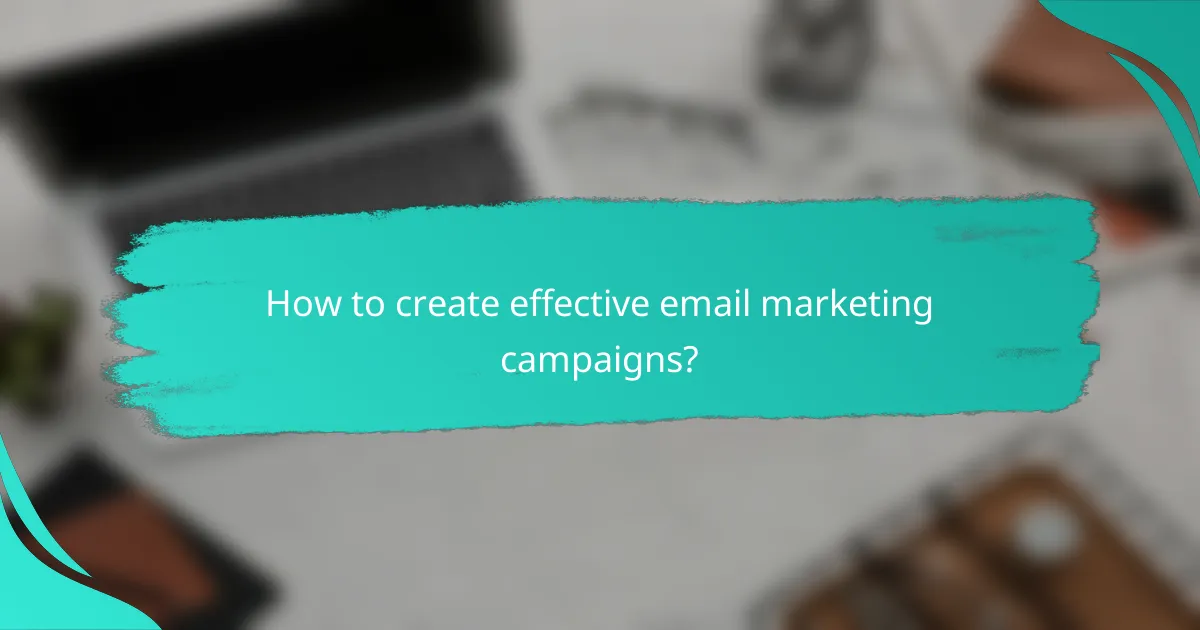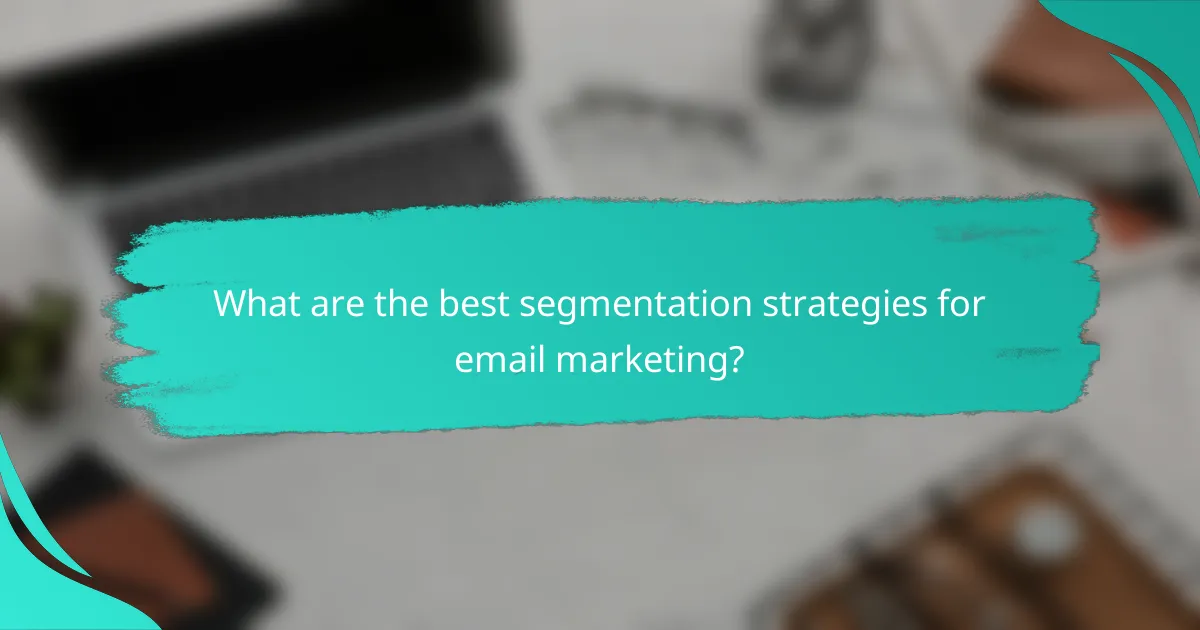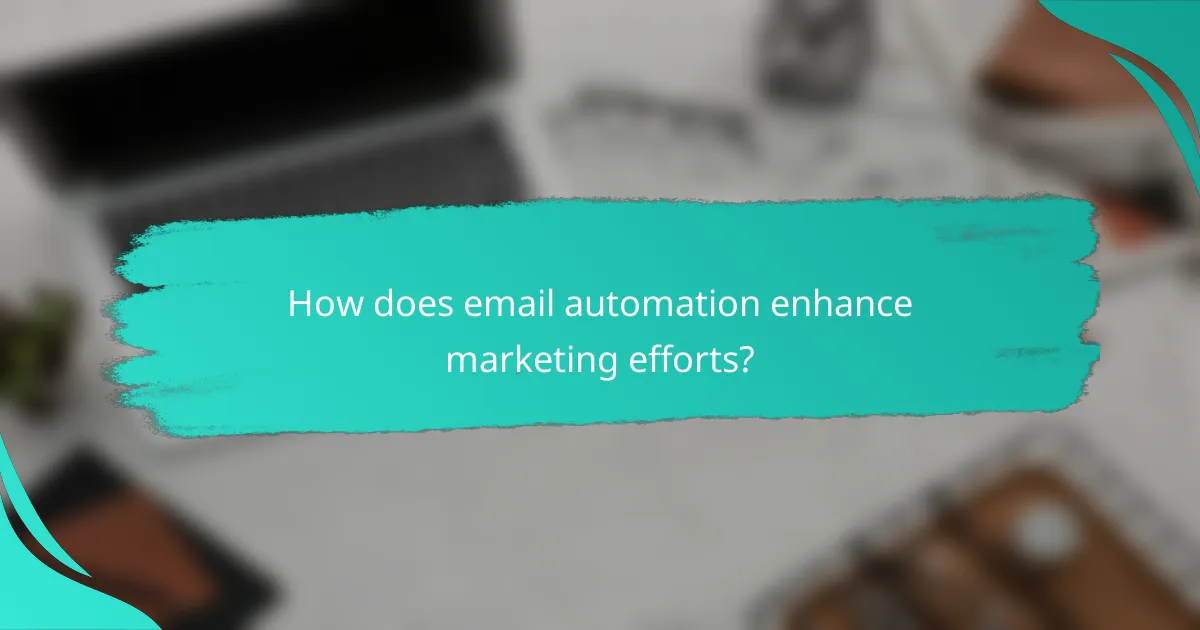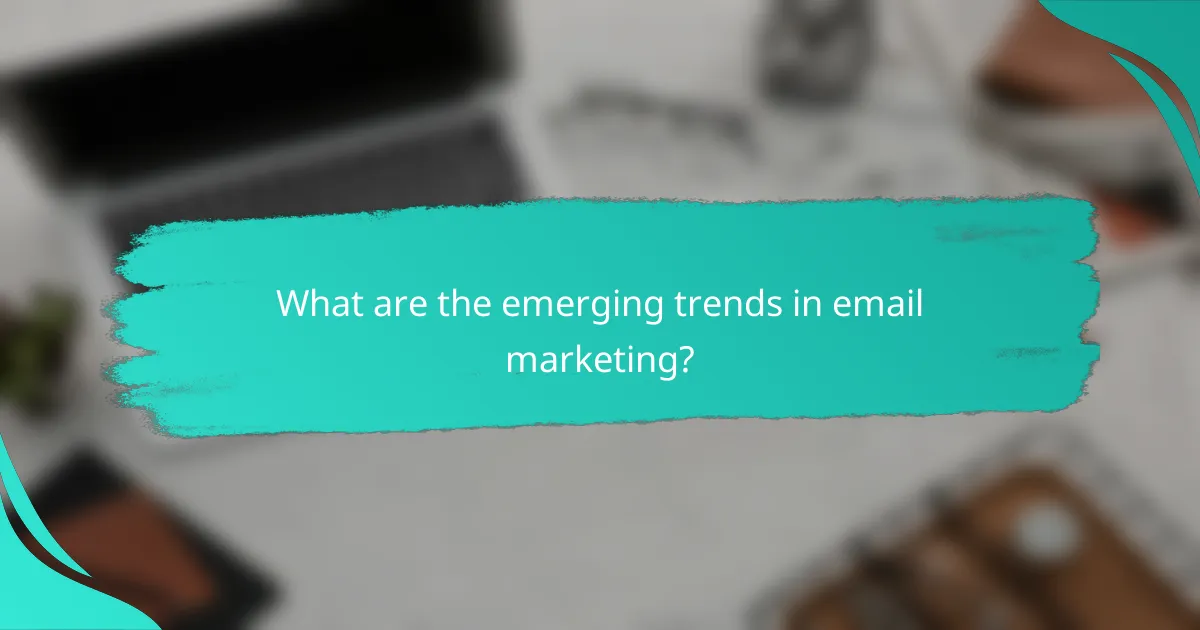Email marketing is a powerful tool for businesses looking to engage their audience and drive conversions. By creating targeted campaigns, segmenting your audience effectively, and utilizing automation, you can enhance communication and deliver personalized content that resonates with your customers. Focusing on these strategies will help you achieve your marketing objectives and foster stronger relationships with your audience.

How to create effective email marketing campaigns?
Creating effective email marketing campaigns involves setting clear objectives, selecting the right tools, and crafting engaging content that resonates with your audience. By focusing on these key areas, you can enhance engagement and drive conversions.
Define campaign goals
Defining campaign goals is crucial for guiding your email marketing efforts. Common objectives include increasing brand awareness, generating leads, or boosting sales. Establish specific, measurable targets to track your progress effectively.
For example, aim to achieve a 20% increase in open rates or generate a certain number of leads within a specified timeframe. This clarity will help you tailor your content and strategies accordingly.
Choose the right email platform
Selecting the right email platform is essential for executing your campaigns efficiently. Consider factors such as ease of use, automation capabilities, and integration with other tools. Popular platforms include Mailchimp, Constant Contact, and Sendinblue.
Evaluate pricing structures and features to find a solution that fits your budget and meets your needs. Many platforms offer free trials, allowing you to test functionality before committing.
Craft compelling subject lines
Compelling subject lines are vital for capturing your audience’s attention and encouraging them to open your emails. Aim for clarity, urgency, and relevance while keeping it concise—ideally under 50 characters.
Utilize personalization techniques, such as including the recipient’s name or referencing their previous interactions. A/B testing different subject lines can help identify what resonates best with your audience.
Design mobile-friendly templates
With a significant portion of emails opened on mobile devices, designing mobile-friendly templates is essential. Ensure your emails are responsive, meaning they automatically adjust to fit various screen sizes.
Use a single-column layout, large fonts, and clear calls to action to enhance readability. Test your designs on multiple devices to ensure a seamless user experience across platforms.
Test and optimize content
Regularly testing and optimizing your email content can significantly improve performance. Implement A/B testing for different elements, such as subject lines, images, and calls to action, to determine what works best.
Analyze metrics like open rates, click-through rates, and conversion rates to identify areas for improvement. Continuously refine your approach based on data insights to maximize engagement and effectiveness.

What are the best segmentation strategies for email marketing?
The best segmentation strategies for email marketing involve dividing your audience into specific groups based on shared characteristics. This targeted approach enhances engagement and improves the effectiveness of your campaigns.
Demographic segmentation
Demographic segmentation focuses on characteristics such as age, gender, income, education, and occupation. By understanding these traits, marketers can tailor their messages to resonate with specific groups. For instance, a luxury brand may target higher-income individuals, while a youth-oriented product might focus on younger demographics.
When implementing demographic segmentation, consider using surveys or data analytics to gather relevant information. This allows for more personalized content, increasing the likelihood of conversions.
Behavioral segmentation
Behavioral segmentation categorizes customers based on their interactions with your brand, including purchase history, email engagement, and website activity. This strategy helps identify patterns in consumer behavior, enabling marketers to send timely and relevant messages.
For example, customers who frequently open emails but rarely make purchases may benefit from special offers or reminders. Conversely, loyal customers could receive exclusive content or rewards to strengthen their relationship with the brand.
Geographic segmentation
Geographic segmentation divides your audience based on their location, such as country, region, or city. This approach is particularly useful for businesses with location-specific products or services. For instance, a retailer may promote winter clothing in colder regions while highlighting summer apparel in warmer areas.
Consider local customs, holidays, and language differences when crafting your messages. Tailoring content to fit geographic preferences can significantly enhance engagement and relevance.
Psychographic segmentation
Psychographic segmentation focuses on the attitudes, values, interests, and lifestyles of your audience. This deeper understanding allows marketers to create content that resonates on a personal level. For example, eco-conscious consumers may respond positively to sustainable product promotions.
To effectively implement psychographic segmentation, conduct surveys or analyze social media interactions to gain insights into your audience’s motivations. This information can guide your messaging and improve overall campaign effectiveness.

How does email automation enhance marketing efforts?
Email automation significantly boosts marketing efforts by streamlining communication and personalizing customer interactions. It allows businesses to send timely, relevant messages to their audience, improving engagement and conversion rates.
Automated welcome series
An automated welcome series is a sequence of emails sent to new subscribers, introducing them to your brand and offerings. This series typically includes a warm greeting, an overview of what to expect, and special offers to encourage initial purchases.
To create an effective welcome series, consider sending 2-4 emails over the first week. Each email should build on the last, gradually providing more information and incentives. Avoid overwhelming new subscribers with too much information at once.
Triggered email campaigns
Triggered email campaigns are automated messages sent based on specific actions taken by subscribers, such as signing up for a newsletter or abandoning a shopping cart. These campaigns are designed to engage users at critical moments in their customer journey.
Common examples include cart abandonment reminders and re-engagement emails for inactive subscribers. To optimize these campaigns, ensure that the timing is appropriate and the content is relevant to the action taken, which can significantly enhance response rates.
Drip campaigns
Drip campaigns consist of a series of pre-scheduled emails sent to subscribers over time, nurturing leads and guiding them through the sales funnel. This approach helps maintain engagement and gradually educates potential customers about your products or services.
When designing a drip campaign, focus on delivering valuable content that aligns with the subscriber’s interests. A typical drip campaign might span several weeks, with emails spaced a few days apart. Monitor engagement metrics to adjust the timing and content as needed.
Performance tracking and analytics
Performance tracking and analytics are crucial for assessing the effectiveness of your email automation efforts. By analyzing metrics such as open rates, click-through rates, and conversion rates, you can identify what works and what needs improvement.
Utilize tools that provide detailed insights into subscriber behavior and campaign performance. Regularly review these analytics to refine your strategies, ensuring that your email marketing remains effective and aligned with your business goals.

What criteria should be considered when selecting an email marketing tool?
When selecting an email marketing tool, consider integration capabilities, user interface, pricing, scalability, and customer support. These factors will ensure the tool meets your business needs and enhances your marketing efforts.
Integration capabilities
Integration capabilities refer to how well the email marketing tool connects with other software you use, such as CRM systems, e-commerce platforms, and analytics tools. A tool that easily integrates with existing systems can streamline workflows and improve data accuracy.
Look for tools that offer APIs or pre-built integrations with popular applications. This can save time and reduce manual data entry, allowing for a more efficient marketing process.
User-friendly interface
A user-friendly interface is crucial for effective email marketing. It should allow users to create, edit, and manage campaigns without a steep learning curve. Intuitive navigation and clear design elements can significantly enhance user experience.
Consider tools that offer drag-and-drop editors and customizable templates. These features simplify the design process, making it easier for users with varying levels of technical expertise to create professional-looking emails.
Pricing and scalability
Pricing and scalability are important factors when choosing an email marketing tool. Look for a pricing structure that fits your budget, whether it’s a monthly subscription or pay-as-you-go model. Many tools offer tiered pricing based on the number of subscribers or features.
Ensure the tool can scale with your business growth. As your email list expands, you want a solution that can accommodate increased volume without significant price jumps or limitations on features.
Customer support options
Customer support options can greatly impact your experience with an email marketing tool. Look for providers that offer multiple support channels, such as live chat, email, and phone support. Responsive customer service can help resolve issues quickly and keep your campaigns running smoothly.
Check for available resources like tutorials, FAQs, and community forums. These can provide additional assistance and help you make the most of the tool’s features, especially during the initial setup phase.

What are the emerging trends in email marketing?
Emerging trends in email marketing focus on personalization, automation, and integration with other digital channels. Marketers are increasingly leveraging data analytics and artificial intelligence to enhance customer engagement and improve campaign effectiveness.
Personalization and Dynamic Content
Personalization involves tailoring email content to individual recipients based on their preferences and behaviors. Dynamic content allows marketers to change elements within an email in real-time, ensuring that each recipient sees the most relevant information. For instance, using a subscriber’s name or recommending products based on past purchases can significantly increase engagement rates.
To effectively implement personalization, collect data through sign-up forms and track user interactions. Aim for a balance between personalization and privacy, ensuring compliance with regulations like GDPR in Europe.
Email Automation
Email automation streamlines the process of sending targeted messages based on specific triggers, such as user actions or significant dates. Automated campaigns can include welcome emails, birthday greetings, or re-engagement messages for inactive subscribers. This saves time and ensures timely communication with customers.
Consider using marketing automation platforms that offer user-friendly interfaces and robust analytics. Set clear objectives for each automated campaign and regularly review performance metrics to optimize results.
Integration with Other Channels
Integrating email marketing with social media and other digital channels enhances overall marketing effectiveness. This approach allows for a cohesive customer experience and can drive traffic across platforms. For example, sharing email content on social media can increase visibility and engagement.
Utilize tools that allow for cross-channel tracking to measure the impact of integrated campaigns. Ensure consistent messaging across all channels to reinforce brand identity and improve customer recognition.
